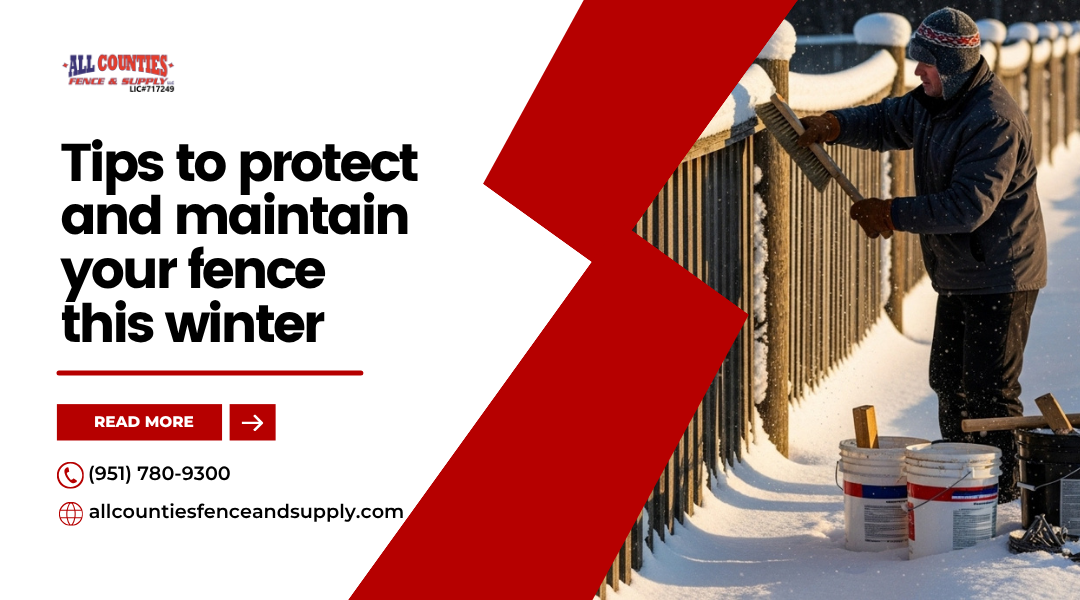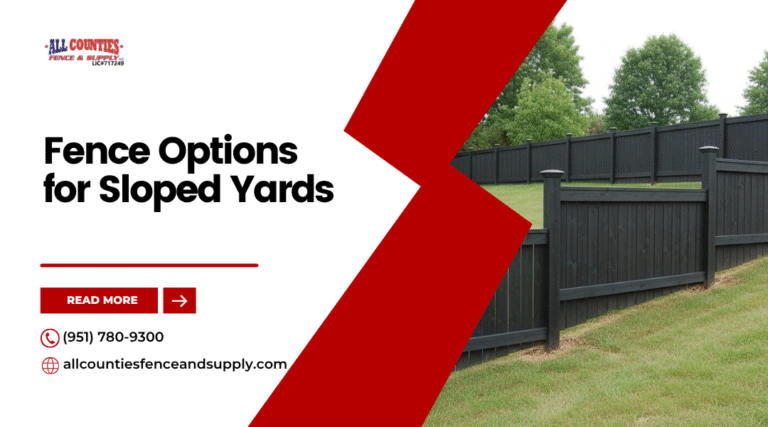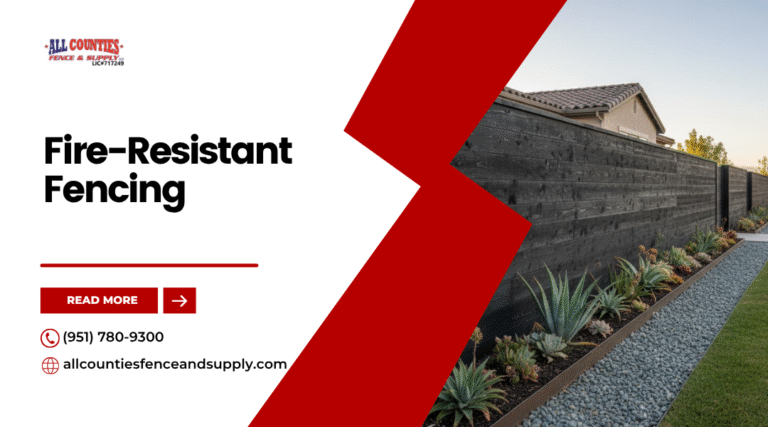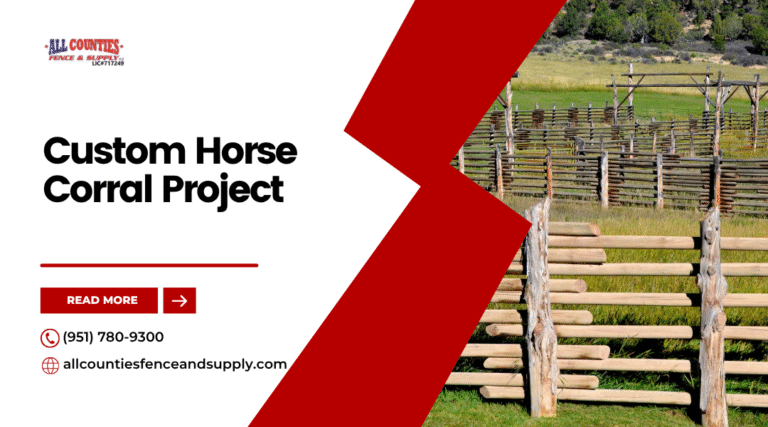Southern California may not face snowstorms or freezing temperatures, but winter rain and moisture can still wear down your fence over time. Wood can swell, metal can rust, and even vinyl can warp if not properly maintained. By winter-proofing your fence, you extend its life, preserve its appearance, and avoid costly repairs when the wet season arrives.
You’ll learn how local weather patterns affect different fence materials and what steps protect each type best. From sealing and drainage to choosing the right products for Southern California’s mild yet unpredictable winters, small efforts now can prevent major damage later.
At All Counties Fence & Supply, you’ll find practical guidance built on decades of experience serving Riverside and surrounding areas. With the right preparation, your fence can stay strong, secure, and attractive all winter long.
Understanding Southern California’s Winter Climate
Southern California’s winters bring cooler temperatures, short bursts of heavy rain, and strong winds that can wear down outdoor structures. These seasonal changes affect fence materials differently, often leading to moisture damage, rust, or warping if left unprotected.
Mild Weather, Hidden Risks for Fences
You might think mild winters mean your fence is safe, but the region’s mix of dry days and sudden rainstorms creates unique challenges. Moisture can seep into small cracks in wood or metal, causing gradual deterioration.
Wood fences may swell, soften, or grow mold after repeated exposure to damp air. Metal fences, while sturdy, can corrode when rainwater sits on unprotected surfaces. Even vinyl or composite fences can warp if drainage is poor.
Typical winter conditions in Southern California:
| Weather Factor | Common Impact on Fences |
|---|---|
| Rainstorms | Trapped moisture, rot, or rust |
| Wind | Loose posts or shifted panels |
| Temperature swings | Expansion and contraction of materials |
Regular inspections after storms help you spot early signs of damage. Addressing small issues quickly prevents them from becoming costly repairs later.
Why Preventive Care Matters Even Without Snow
Even without snow or freezing temperatures, winter moisture and wind can shorten your fence’s lifespan. You need to protect it before the rainy season begins.
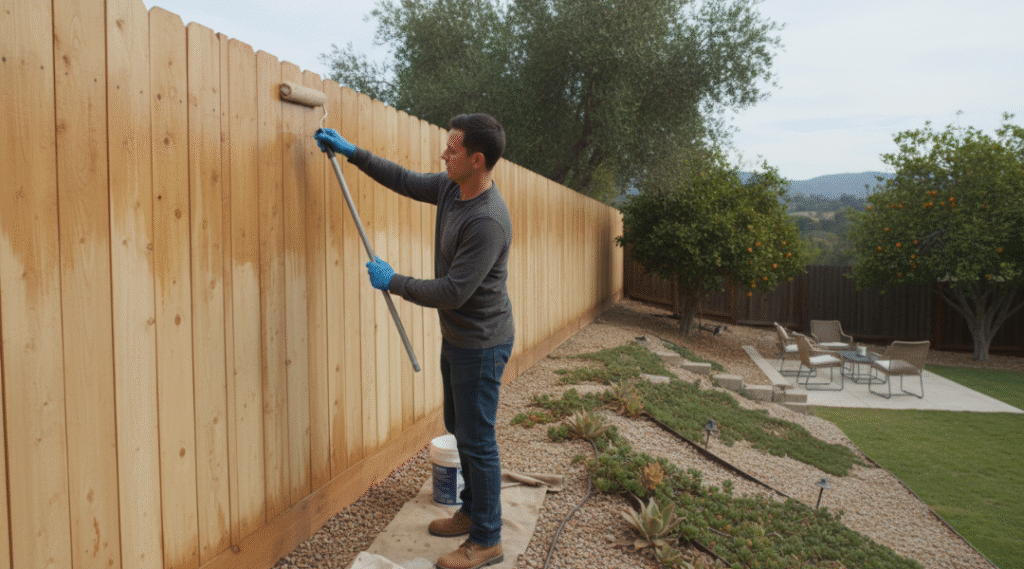
Applying a waterproof sealant or rust-resistant coating creates a barrier against moisture. Keeping soil and plants from touching the base of your fence also improves airflow and drainage.
Check that your yard slopes slightly away from fence posts to keep water from pooling. Tighten loose hardware and replace cracked boards or panels. These small steps reduce long-term wear and protect your investment from the region’s unpredictable winter weather.
Common Winter Challenges for Different Fence Types
Even though Southern California winters are mild, cooler temperatures, rain, and coastal moisture can still cause fence damage. Materials like wood, vinyl, iron, and chain-link each respond differently to these conditions, and knowing how they behave helps you prevent costly repairs.
Wood Fences: Moisture, Rot, and Warping
Wood fences absorb moisture easily, which can lead to rot and warping when temperatures drop or humidity rises. Rainwater and morning dew often settle on boards, especially if the wood is untreated or the sealant has worn off.
You may notice discoloration, soft spots, or splitting boards after several wet days. These signs show that water has penetrated the surface. In shaded areas, trapped moisture can also cause mildew or fungus growth.
To reduce damage, keep soil and mulch from touching the bottom of your fence. Apply a water-repellent sealant once a year, and clean away leaves or debris that hold moisture. Proper drainage around your yard prevents standing water from soaking into the posts.
Vinyl Fences: Cracking and Fading from Temperature Swings
Vinyl fencing resists moisture, but it can still suffer from cracking and color fading when temperatures shift quickly. In Southern California, daytime warmth followed by cool nights causes the material to expand and contract. Over time, this stress weakens panels and joints.
Direct sunlight also fades lighter vinyl colors, especially white and beige. Dirt and dust buildup can make fading appear worse. Coastal salt exposure may leave a film that dulls the surface.
You can protect your vinyl fence by washing it with mild soap and water every few months. Use a UV-resistant finish or cleaner to maintain color. Avoid leaning heavy objects against panels to prevent stress cracks.
Iron Fences: Rust and Corrosion in Coastal Areas
Iron and other metal fences are strong but vulnerable to rust and corrosion, especially near the ocean. Salt in the air accelerates oxidation, creating reddish-brown spots that spread if untreated. Rain and morning fog make this worse by keeping surfaces damp.
Inspect your fence regularly for chipped paint or scratches that expose bare metal. Once rust appears, clean it with a wire brush and apply a rust-inhibiting primer and paint.
For extra protection, choose powder-coated finishes that resist corrosion better than standard paint. Rinsing your fence with fresh water every few weeks helps remove salt buildup and slows down rust formation.
Chain-Link Fences: Shifting Soil and Loose Posts
Chain-link fences handle moisture well, but their posts and foundations can shift when soil becomes saturated. In areas with clay or poorly drained ground, heavy rain can cause the base to move, leaving the fence uneven or loose.
Rust can also form on older galvanized metal, especially where the coating has worn away. Loose fittings, sagging mesh, or leaning posts are early signs of movement or corrosion.
To maintain stability, check that your posts remain firm after storms. Add gravel around the base for better drainage. Applying a protective zinc coating or paint can extend the life of your chain-link fence in damp or coastal conditions.
Step-by-Step Guide to Winter-Proofing Your Fence
Cold nights, heavy rain, and shifting soil can wear down fences over time. Regular inspection, cleaning, sealing, and drainage control help prevent early damage and keep your fence stable through the wet season. Small maintenance steps now can stop costly repairs later.
Inspect for Existing Damage Before Winter
Walk along your fence and look for loose boards, cracks, leaning posts, or rusted fasteners. Even minor issues can worsen when exposed to moisture. Use a screwdriver or small hammer to test for soft spots in wooden boards that may show early rot.
Check metal or vinyl fences for corrosion or brittle areas. Replace or tighten any missing nails, screws, or brackets. If a post leans, dig around the base to see if the soil has shifted or eroded.
Make a short checklist to track repairs before the first heavy rain. Fixing these problems early keeps your structure strong and prevents water from spreading through weak points.
Clean and Treat Fence Surfaces (Sealants, Paints, or Coatings)
Clean surfaces allow protective coatings to bond well. Use a mild detergent and a soft brush to remove dirt, mildew, and debris. Rinse thoroughly and let the fence dry for at least 24 hours before applying any treatment.
For wood fences, apply a water-repellent sealer or oil-based stain that resists moisture and UV damage. These products protect against swelling, cracking, and discoloration. Composite or vinyl fences may only need a gentle wash and a coating of UV-protective spray.
If your fence is metal, remove rust with a wire brush and apply rust-resistant primer and paint. Always follow the manufacturer’s drying times and apply coatings in mild, dry weather for best results.
Reinforce Posts and Check Ground Stability
Southern California’s soil can shift after rain, which weakens fence posts. Check that each post stands straight and feels firm when pushed. If it wobbles, compact the soil around it or add gravel for better drainage and support.
For wooden posts, inspect the base where it meets the ground. If moisture collects there, consider installing metal post anchors or concrete footings to lift the wood off the soil.
A short table can help guide reinforcement options:
| Problem | Solution |
|---|---|
| Loose or leaning post | Add gravel or concrete footing |
| Rotting base | Replace with treated wood or metal anchor |
| Erosion near post | Backfill with compacted soil and improve drainage |
Lubricate Hinges, Latches, and Gate Hardware
Moisture can cause metal parts to rust or seize up. Spray silicone-based lubricant or graphite powder on hinges, latches, and locks to keep them moving smoothly. Avoid heavy oil, which can attract dirt and grime.
Inspect screws and bolts for rust and replace any that are corroded. Tighten loose hardware to prevent gates from sagging or misaligning.
If your gate drags on the ground, adjust the hinge screws or add a small shim to lift it slightly. Regular lubrication reduces friction, prevents rust buildup, and extends the life of your gate components.
Manage Drainage Around Fence Lines
Poor drainage can cause soil erosion and weaken your fence foundation. Walk the fence line after rain to see where water pools or flows toward posts. Redirect runoff using gravel trenches, French drains, or slight grading away from the fence.
Keep plants, mulch, or soil from piling against the fence base. Trapped moisture can lead to rot or rust.
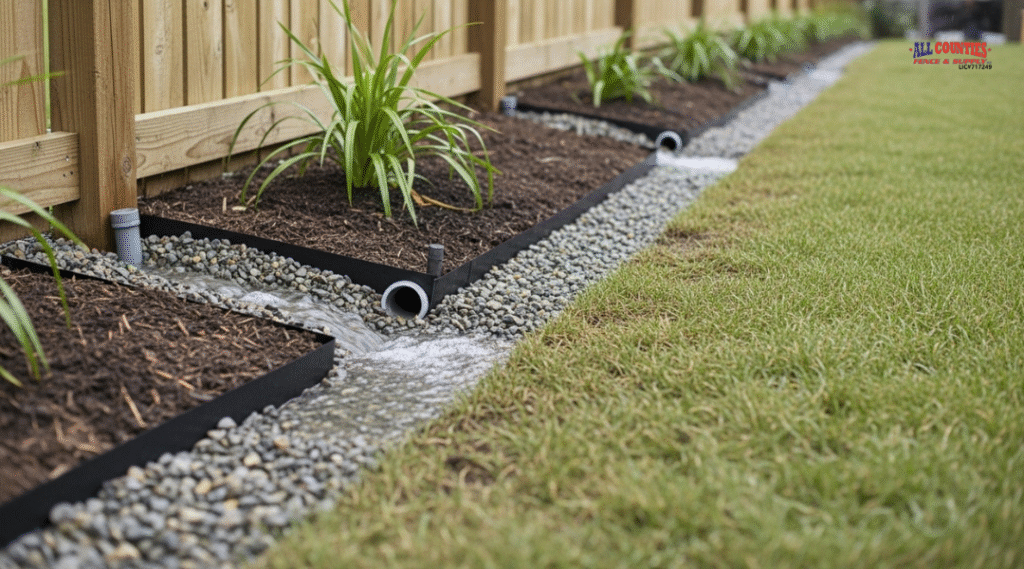
If your property sits on a slope, install drainage channels or retaining borders to guide water safely downhill. Managing water flow keeps your fence stable, prevents decay, and reduces long-term maintenance.
Materials and Products That Perform Best in Southern California
Mild winters and dry conditions in Southern California mean your fence faces more sun and moisture changes than freezing temperatures. Choosing materials that resist UV damage, corrosion, and water absorption helps your fence last longer and stay low maintenance.
Weather-Resistant Woods (Cedar, Redwood)
Cedar and redwood stand out because they contain natural oils that resist decay and insects. These woods handle Southern California’s mild winter rain without swelling or warping. Their tight grain also helps prevent cracking from temperature changes.
Use kiln-dried boards to reduce moisture content before installation. This limits shrinkage and helps paint or stain adhere better. Regularly applying a clear, oil-based sealant every few years keeps the surface protected from UV rays and rain.
| Property | Cedar | Redwood |
|---|---|---|
| Natural rot resistance | High | Very high |
| Maintenance level | Moderate | Low |
| Best finish | Oil-based sealant | Semi-transparent stain |
Avoid pressure-treated wood unless you need extra ground contact protection, as it can discolor and require more upkeep in dry climates.
UV-Stabilized Vinyl and Powder-Coated Iron
Vinyl fences perform well in coastal and desert areas because they resist moisture and salt air. Look for UV-stabilized vinyl that includes titanium dioxide to prevent brittleness and fading from constant sunlight. Clean the surface with mild soap to remove dust and salt buildup.
Powder-coated iron offers strength and a sleek look without the rust issues of bare steel. The powder coating acts as a barrier against oxidation and scratches. Choose lighter colors if your fence gets direct sun, since darker finishes absorb more heat and may fade faster.
Both materials need little maintenance beyond cleaning and inspection for cracks or chipped coatings.
Eco-Friendly Sealants and Rust Inhibitors
Sealants and rust inhibitors extend the life of wood and metal fences by blocking moisture and oxygen. For wood, choose low-VOC, water-based sealants that penetrate the grain without leaving a thick film. These products dry quickly and are safer for plants and pets.
On metal fences, apply rust inhibitors or corrosion-resistant primers before repainting any exposed areas. These coatings stop oxidation from spreading under the paint. Use a small brush for touch-ups around joints and fasteners, where rust often starts.
Reapply sealants or inhibitors every two to three years, depending on exposure. This simple maintenance step helps prevent costly repairs and keeps your fence looking clean and stable year-round.
Maintenance Schedule and Long-Term Care Tips
Keeping your fence in good shape through the cooler months requires steady attention. Regular inspections, timely cleaning, and small repairs prevent costly damage later and help your fence stay secure and attractive year-round.
Pre-Winter Checklist
Before winter rains arrive, inspect your fence for weak points. Look for loose boards, rusted nails, or cracked posts. Tighten or replace any damaged hardware. For wood fences, apply a weather-resistant sealant or stain to reduce moisture absorption.
Remove dirt, leaves, and debris from around the fence base. Trapped moisture can lead to rot or corrosion. Trim back vegetation that touches the fence to improve airflow and reduce mold growth.
If you have a metal fence, check for signs of rust and sand those spots before applying a rust-inhibiting primer. Vinyl fences may need a gentle wash with mild soap and water to prevent buildup. Completing these tasks in late fall helps your fence handle winter weather more effectively.
Mid-Winter Inspections After Heavy Rain
Southern California’s winter rains can cause soil movement and moisture damage. After each major storm, walk the fence line to check for leaning posts, soft soil, or water pooling near the base.
Use a small shovel to redirect water away from posts if you see puddles forming. This simple step helps prevent rot and instability. Examine gates and hinges for swelling or misalignment caused by shifting ground. Lubricate metal parts to keep them moving smoothly.
If you notice discoloration or mildew, clean affected areas using a diluted vinegar solution or gentle outdoor cleaner. Avoid pressure washing wood fences during wet periods, as excess moisture can worsen existing cracks or warping.
Post-Winter Touch-Ups to Extend Fence Life
Once the rainy season ends, focus on restoring and reinforcing your fence. Reapply sealant or paint where finish has worn away. Fill small cracks or holes with wood filler before sealing to block future moisture intrusion.
For metal fences, check joints and welds for rust or weakness. Apply protective coatings to prevent new corrosion. Vinyl fences may only need a light wash to remove dirt and mineral stains.
Create a simple maintenance log to track inspections, repairs, and treatments:
| Task | Recommended Timing |
|---|---|
| Cleaning | Every 2–3 months |
| Sealant or paint touch-up | Once a year |
| Hardware check | Spring and fall |
Consistent care through each season helps your fence last longer and maintain its appearance with minimal effort.
When to Call a Professional
Some fence issues require more than routine maintenance. You may need expert help when damage affects structural stability or when you want to upgrade to materials that better handle winter moisture and temperature changes.
Structural Repairs Beyond DIY Scope
If your fence leans, sags, or has rotted posts, it’s time to call a professional. These problems often mean the foundation or support system has weakened. Replacing posts or resetting footings correctly requires specialized tools and knowledge of soil conditions common in Southern California.
A professional can also check for hidden damage caused by termites, rust, or internal rot. These issues can spread quickly if untreated. Attempting major repairs without the right skills can worsen structural problems or void warranties.
Signs you need expert help:
- Posts move when pushed
- Sections separate or tilt unevenly
- Boards or panels show deep cracks or decay
- Gates no longer align or latch properly
Hiring a licensed contractor ensures the fence meets local building codes and can withstand winter rain and wind.
Upgrading to More Weather-Resilient Materials
If your current fence material struggles with moisture or sun exposure, upgrading may save long-term costs. Professionals can recommend materials suited to Southern California’s mild winters and occasional heavy rain.
Common upgrades include:
| Material | Benefits | Maintenance Level |
|---|---|---|
| Vinyl | Resists rot, moisture, and insects | Low |
| Metal (aluminum or steel) | Strong and durable | Moderate |
| Pressure-treated wood | Better moisture resistance | Medium |
A professional installer can properly seal, anchor, and finish materials to prevent water entry and corrosion. They can also apply weatherproof coatings and ensure drainage around posts is adequate.
Consulting an expert helps you choose materials that balance cost, appearance, and long-term durability.
Additional Ways to Protect Your Property in Winter
Cold nights and heavy rain can affect more than your fence. Good drainage and regular yard care help prevent soil erosion, flooding, and structural wear that often occur during Southern California’s winter storms.
Landscape Grading and Drainage Control
Proper grading keeps water from pooling near your fence or home foundation. You should make sure the soil slopes away from structures at a rate of about 1 inch per foot for the first 6 feet. This small adjustment helps direct water runoff toward safe drainage areas.
If you notice standing water after rain, check for low spots or blocked drains. Installing a French drain or gravel-filled trench can improve water flow. In clay-heavy soil, adding sand or compost improves permeability and reduces runoff.
A simple inspection checklist can help:
| Task | Frequency | Purpose |
|---|---|---|
| Check slope direction | Twice a year | Prevents water pooling |
| Clean gutters and downspouts | Before rainy season | Reduces overflow near fence |
| Inspect drainage pipes | After heavy rain | Ensures proper flow |
Keeping water away from your property’s perimeter helps preserve both the fence posts and the foundation’s stability.
Integrating Fencing with Seasonal Yard Maintenance
Winter yard care supports your fence’s durability. Trim overhanging branches that could break during storms and damage panels. Clear fallen leaves to prevent moisture buildup that can cause wood rot or rust on metal fences.
You should also inspect nearby shrubs. Dense vegetation traps moisture and limits airflow, which can weaken fence materials over time. Maintain at least a 6-inch gap between plants and the fence line.
Apply mulch around plants to control weeds and retain soil moisture, but keep it a few inches away from the fence base to avoid trapping water. Combine these steps with routine cleaning and minor repairs to keep your yard and fence in stable condition through the season.

